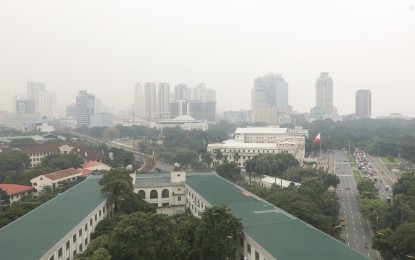
HAZY SKY. A thin layer of smoke appears to cover the sky in this part of Metro Manila on Friday (Sept. 22, 2023). Some people believed the haze was caused by vog coming from the restive Taal Volcano but the Department of Environment and Natural Resources-Environmental Management Bureau (DENR-EMB) said the smog is unrelated to it and is primarily attributed to vehicular emissions, especially during rush hours. (PNA file photo)
MANILA – The smog that enveloped Metro Manila on Friday has disappeared, the weather bureau reported on Saturday.
According to Juanito Galang, chief of the Weather Division of the Philippine Atmospheric, Geophysical, and Astronomical Services Administration (PAGASA), the downpour caused by the southwest monsoon or “habagat” and low-pressure area experienced Friday night until Saturday morning has weakened the smog.
“So right now, we can see... that it has weakened a bit or is clearing a bit. It rained heavily this morning or last night. That's a factor that the wind is moving a bit compared to yesterday,” he said at the Saturday News Forum in Quezon City. “So gradually, we will notice that it is getting clear here in Metro Manila.”
The smog that covered many parts of Metro Manila and some areas of Central Luzon was also not caused by volcanic smog or vog from Taal volcano, Galang added.
Technically, he said, it was called photochemical smog that comes from pollutants, such as emissions of vehicles and industries.
The geographical location of Metro Manila is also a factor, he said.
“The geographical location of Metro Manila is still a factor. If we can see Metro Manila, it is on the edge of the valley. If we look at the map of Luzon, Metro Manila can be considered part of the valley. So, there is also a factor called… meteorological condition part, thermal inversion,” he added.
Thermal inversion, he explained, is “a layer in the atmosphere that is your cold air or your cold air, trapped by the warm air because of that, those particulates can't move, so it accumulates and then forms smog.”
Galang reminded the public to wear a face mask if such a phenomenon recurs.
Smog blanketed Metro Manila on Friday, prompting local government units to cancel classes in private and public schools. (PNA)
